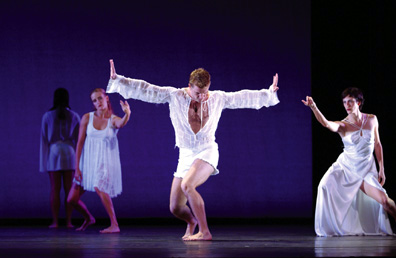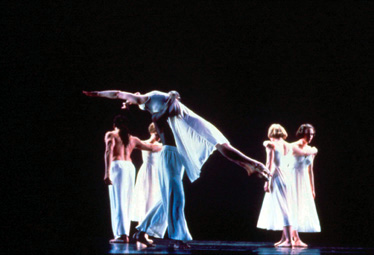Old Friends
A
Lake/Marble Halls/I Don't Want to Love/Jesu, Meine Freude
Mark Morris Dance Group
Moztly Mozart Festival
New York State Theater
August 19, 2004
By
Susan Reiter
copyright
© 2004 by Susan Reiter
published August 30, 2004
 It
felt like a trip back in time, the program of Mark Morris works dating
from 1985 to 1986 that his company performed with such singular grace
and generosity for what has become its annual Moztly Mozart appearance.
We are so used to seeing Mr. Morris's latest musical explorations (Lou
Harrison, Bartok) being the main focus of a program, with the occasional
less-recent work filling out the bill. Here, on a program whose musical
choices certainly offered nothing jarring for the average Mostly Mozart
audience member, was a chance to focus on early-to-middle-period Morris.
It
felt like a trip back in time, the program of Mark Morris works dating
from 1985 to 1986 that his company performed with such singular grace
and generosity for what has become its annual Moztly Mozart appearance.
We are so used to seeing Mr. Morris's latest musical explorations (Lou
Harrison, Bartok) being the main focus of a program, with the occasional
less-recent work filling out the bill. Here, on a program whose musical
choices certainly offered nothing jarring for the average Mostly Mozart
audience member, was a chance to focus on early-to-middle-period Morris.
The Orchestra of St. Luke's, conduced by Craig Smith, a longtime collaborator of Mr. Morris, was in the pit providing elegant and eloquent interpretations of the scores by Haydn and Bach. For the program's two vocal works, there were the additional forces of the Waverly Consort and the Voices of Ascension.
Certainly the inclusion of "Marble Halls," a 1985 work that I first saw in that long-ago era when the Morris company performed at Dance Theater Workshop and had not seen for many years, emphasized Mr. Morris's focus on another time. Set to Bach's alternately invigorating and poignant Concerto for Oboe, Violin, Strings and Continuo in C Minor, it takes a brisk, no-nonsense approach to the score. In the cheerful, playful opening movement, three lines of three dancers crisply bound from side to side, as though being pulled along by an invisible link, responding to the music's robust rhythm like kids offered a creative challenge.
The exquisite meandering intertwining oboe and violin lines of the leisurely middle movement inspires a perverse response in Mr. Morris, very different from the extended silhouettes of the self-consciously beautiful male duet that Stanton Welch set to this movement in his ABT ballet "Clear." The Morris interpretation features short, square phrases of matter-of-fact movement, with some striking images interspersed-such as the sight of six dancers swaying with their arms crossed above their heads. During the expansive, nearly hectic merriment of the final movement, Joe Bowie and Michelle Yard bubble through with delightful, fleeting duets that barely register before they are swept along by the ongoing surge of activity. When, on the finale note of the score the stage magically clears, it is a witty, completely appropriate punctuation mark, an ideal way to close the door on al the buoyant fun and vivid energy to which we have just been treated.
 There
is such a clarity and honesty in the way Mr. Morris approaches the music
in "Marble Halls," and I felt that same quality in "A Lake."
In both cases, his way with the score is transparent and can border on
following too closely to the music. He doesn't always transform it and
use it as a basis for illumination in the way Balanchine does wit a score,
but he always makes you enter into a dialogue with the music, feel its
possibilities, to a degree you might not have otherwise. "A Lake,"
one of the works Mr. Morris choreographed for White Oak Dance Project
during its initial season, is a luminous, deceptively simple-looking work
that makes its journey through Haydn's Concerto for Horn and Strings in
D Major feel like a gentle glide through the water in a pristine natural
setting. It soothes, caresses and shimmers.
There
is such a clarity and honesty in the way Mr. Morris approaches the music
in "Marble Halls," and I felt that same quality in "A Lake."
In both cases, his way with the score is transparent and can border on
following too closely to the music. He doesn't always transform it and
use it as a basis for illumination in the way Balanchine does wit a score,
but he always makes you enter into a dialogue with the music, feel its
possibilities, to a degree you might not have otherwise. "A Lake,"
one of the works Mr. Morris choreographed for White Oak Dance Project
during its initial season, is a luminous, deceptively simple-looking work
that makes its journey through Haydn's Concerto for Horn and Strings in
D Major feel like a gentle glide through the water in a pristine natural
setting. It soothes, caresses and shimmers.
The ten dancers wear Martin Pakledinaz's gentle evocation of 18th-century garb —knee britches and simple vests in very soft, pale shades of blue and green. In the first movement, the stately procession of dancers with carefully positioned arms evoked a sense of decorum and restraint. A recurring motif of one hand held at the waist, the other reaching outward in a gentle curve, suggested a world of politesse and graciousness. The delicious cadenza for David Leventhal, joined by Mr. Bowie, captured in movement the rococo deliciousness of the solo horn's flourishes.
The central adagio, in a minor key, set Michelle Yard apart from and outside of a group, and evoked a quietly haunting scenario through its spare deployment of the dancers and use of stillness. The third movement, despite an occasional over-emphasis on following the music's beat too obviously, contained many delights, beginning with Mr. Leventhal and Mr. Bowie bonding with the sweet simplicity of kids at play. The movement unfolds with a genial, unforced sense of wit and exuberance that keys off Haydn's buoyant rhythms, and towards the end there is a charming sequence of Mr. Leventhal (whose beautifully free, open dancing is such a consistent pleasure) leading the ensemble on and off. I'm guessing this was originally Mikhail Baryhnikov's role, which would have given the action an added little fillip of wit.
The seven Monteverdi madrigals to which Mr. Morris set his 1996 "I Don't Want to Love" are achingly pensive and delicate, worlds away from the courtly pleasures of Haydn. The seven dancers wear Isaac Mizrahi's inventive mix of white costumes in materials both silky and gossamer-sheer, ranging from baby-doll pajamas to an elegant evening gown, which are initially distracting because of their variety of styles. Performed by a crème-de-la-crème of Mr. Morris's dancers, accompanied by the refined early-music specialists of the Waverly Consort (four singers and four musicians, amplified from the stage-right corner of the pit), "I Don't Want to Love" is an achingly exquisite experience, a perfectly balanced meeting of music and dance in which each enhances the other. There are unexpected moments full of surprise, in which somehow Mr. Morris makes the stage picture and Monteverdi come together with a sense of inevitability. This was my second viewing of this work, and both times it left an intense resonance that somehow defies details description.
Bach's motet "Jesu, Meine Freude" provides the title for the program's closing work, which premiered in 1993. It was performed by the vocal group Voices of Ascension, with continuo accompaniment on cello, bass and organ. What is striking in this later venture by Mr. Morris into Bach is the way he sculpts both the individual bodies and the stage space. The recurring chorale melody, appearing in different guises that (as the program note states) "introduce various degrees of contrapuntal elaboration," is ripe fodder for Mr. Morris's ingenious musical mind. But watching the dance, one never feels as though one is being given a guided tour through Bach's structural intricacies. Nor is the deeply religious text in any literal way brought to the fore. Rather, the fluid, shifting groupings incorporate images of ardor and devotion within the deeply arched shapes created by the dancers' fluid torsos.
With the two concertos, both following a fast-slow-fast movement structure, making up the first half of the program, and the two more delicate, non-orchestral vocal works comprising the second half, the evening felt unbalanced. It might have been more logical to open with one of the concertos and close with the other, with the two vocal works framing the intermission. Mr. Morris must have had solid reasons (musical and logistical) for the way he shaped the program, and it did offer an intriguing development from a more public, outward-looking sensibility towards a more private, meditative, inward arena of mystery and reflection. And as I left the theater, I felt as though I'd been cleansed, re-focused, illuminated and inspired.
Photos of the Mark
Morris Dance Group:
First by Robbie Jack
Second, by Tom Brazil.
Originally
published:
www.danceviewtimes.com
Volume 2, No. 33
August 30, 2004
Copyright
©2004 by Susan Reiter
|
|
|